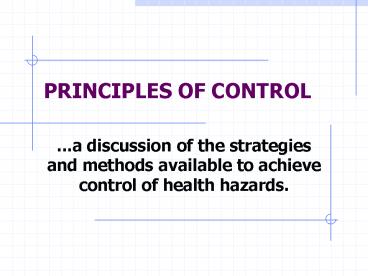PRINCIPLES OF CONTROL - PowerPoint PPT Presentation
1 / 15
Title:
PRINCIPLES OF CONTROL
Description:
CONTROL ASSUMPTIONS All hazards can be ... Stores, offices, warehouses Tobacco ... used for toxic materials some examples PRINCIPLES OF ... – PowerPoint PPT presentation
Number of Views:121
Avg rating:3.0/5.0
Title: PRINCIPLES OF CONTROL
1
PRINCIPLES OF CONTROL
- ...a discussion of the strategies and methods
available to achieve control of health hazards.
2
CONTROL ASSUMPTIONS
- All hazards can be controlled to some degree by
some method. - Alternative approaches are available.
- More than one approach may be needed.
- Cost-effectiveness varies with approach.
- A given approach may not completely control the
hazard.
3
HIERARCHY OF CONTROL STRATEGIES
- PREVENTION (?)
- ENGINEERING
- ADMINISTRATIVE
- includes work practices
- PERSONAL PROTECTION
4
SITUATION NO. 1
- Design of a plan for assembly of metal cabinets
included a need to join several pieces of metal
together and welding was being considered. - Traditional exposure control is based on
ventilation and/or respirators. - What are some prevention options for the IH?
5
CONTROL BEGINS _at_ DESIGN
- technologically more difficult to retrofit
- always more expensive after design
- industrial hygiene input to design
- design criteria must include consideration for
worker safety - Institute for Safety Through Design
6
IMPLEMENTING CONTROLS
- Identify the hazard.
- Define sources of exposure.
- Characterize worker involvement.
- Understand air flow patterns.
- Examine control options.
- Select/implement proper controls.
- Follow-up, test, maintain controls.
7
SITUATION NO. 2
- A plan view of a grain handling system in a food
manufacturing plant - Two workers in the building
- emissions, air movement, worker activities, etc.
8
ENGINEERING CONTROLS
- SUBSTITUTION
- ISOLATION
- ENCLOSURE
- PROCESS MODIFICATION
- VENTILATION
- DILUTION
- LOCAL EXHAUST
9
Industrial vs. Non-industrial Environments
- Industrial
- Mines, manufacturing facilities, plants
- Dusts from mines, solvents, heavy metals, vehicle
emissions, grinding - Non-industrial
- Stores, offices, warehouses
- Tobacco smoke, ozone, mold spores, formaldehyde,
products from remodeling (adhesives, paints),
cleaners
10
A word about contaminant form...
- particulates
- dusts
- fumes
- smoke
- fibers
- mists/fogs
- gases
- vapors
11
SUBSTITUTION
- generally applies to chemical hazards
- a hazardous material is replaced by one of less
hazard - some examples
- potential problems with this approach
12
ISOLATION/CONTAINMENT
- a barrier is placed between hazard and workers
- physical or distance
- some examples
- potential problems with this approach
13
PROCESS MODIFICATION
- equipment, or its use, is modified so as to
reduce hazard - some examples
- potential problems with this approach
14
GENERAL VENTILATION
- contaminant is diluted to acceptable level
- usually less effective than LEV
- not for settleable contaminants
- some examples
15
LOCAL EXHAUST
- contaminant is captured at or near point of
release - usually the most desirable approach
- can be used for toxic materials
- some examples































